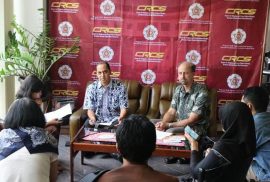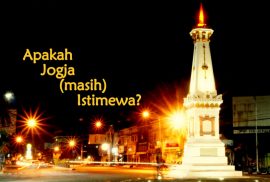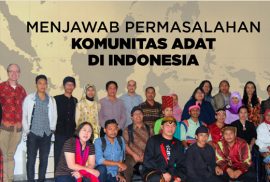 Setelah Reformasi 1998, dalam situasi transisi menuju demokrasi, Indonesia dikejutkan dengan makin maraknya konflik-konflik bernuansa agama dan etnis, dan beberapa di antaranya hingga memakan korban jiwa dalam hitungan ribuan. Demokrasi membuka saluran yang tersumbat selama beberapa dasawarsa sebelumnya, dan ternyata tidak otomatis membawa pada kedamaian dan kesejahteraan. Identitas agama dan etnis, khususnya, menjadi bahasa utama untuk membolisiasi massa. Apa yang pada periode Orde Baru diasumsikan sebagai “kerukunan”, sebagai ciri yang dibanggakan Indonesia sebagai masyarakat majemuk, ternyata tampak hanya seperti bangunan yang rapuh. Dan yang lebih penting, ternyata kita tampaknya belum sepenuhnya memahami kemajemukan Indonesia dan bagaimana mengelolanya.
Setelah Reformasi 1998, dalam situasi transisi menuju demokrasi, Indonesia dikejutkan dengan makin maraknya konflik-konflik bernuansa agama dan etnis, dan beberapa di antaranya hingga memakan korban jiwa dalam hitungan ribuan. Demokrasi membuka saluran yang tersumbat selama beberapa dasawarsa sebelumnya, dan ternyata tidak otomatis membawa pada kedamaian dan kesejahteraan. Identitas agama dan etnis, khususnya, menjadi bahasa utama untuk membolisiasi massa. Apa yang pada periode Orde Baru diasumsikan sebagai “kerukunan”, sebagai ciri yang dibanggakan Indonesia sebagai masyarakat majemuk, ternyata tampak hanya seperti bangunan yang rapuh. Dan yang lebih penting, ternyata kita tampaknya belum sepenuhnya memahami kemajemukan Indonesia dan bagaimana mengelolanya.
Articles
Kelli Swazey | CRCS
Kelli Swazey is a lecturer and faculty member of CRCS.
 Saya ingin memulai dengan berbagi cerita tentang pengalaman saya enam bulan yang lalu. Suatu malam dalam perjalanan pulang ke rumah, saya sendirian naik motor dan saya menjadi korban perampokan di Ring Road Utara. Syukurlah, ada para pekerja yang sedang memperbaiki sebuah hotel yang terletak di pinggir jalan tempat saya mengalami perampokan malam itu. Para pekerja itu menyelamatkan saya, karena ketika saya jatuh dari motor, saya sempat pingsan. Orang yang menyelamatkan saya meminta maaf berulang kali. Seperti banyak orang lain yang mendengar cerita tentang musibah yang saya alami, mereka merespon dengan kecurigaan bahwa orang yang menyerang saya pasti orang pendatang. Ternyata, orang-orang yang merampok saya adalah dua anak muda dari Sleman. Salah satu pelakunya masih ABG, berumur sekitar usia anak SMA. Selama diopname di rumah sakit, saya tidak habis pikir dan bertanya pada diri sendiri apa motivasi mereka.
Saya ingin memulai dengan berbagi cerita tentang pengalaman saya enam bulan yang lalu. Suatu malam dalam perjalanan pulang ke rumah, saya sendirian naik motor dan saya menjadi korban perampokan di Ring Road Utara. Syukurlah, ada para pekerja yang sedang memperbaiki sebuah hotel yang terletak di pinggir jalan tempat saya mengalami perampokan malam itu. Para pekerja itu menyelamatkan saya, karena ketika saya jatuh dari motor, saya sempat pingsan. Orang yang menyelamatkan saya meminta maaf berulang kali. Seperti banyak orang lain yang mendengar cerita tentang musibah yang saya alami, mereka merespon dengan kecurigaan bahwa orang yang menyerang saya pasti orang pendatang. Ternyata, orang-orang yang merampok saya adalah dua anak muda dari Sleman. Salah satu pelakunya masih ABG, berumur sekitar usia anak SMA. Selama diopname di rumah sakit, saya tidak habis pikir dan bertanya pada diri sendiri apa motivasi mereka.
Hary Widyantoro, A. S. Sudjatna (Ed.) | Report | CRCS

Kala bermacam identitas—seperti kesukuan dan keagamaan—muncul selepas tumbangnya Orde Baru, makin terkuaklah diskriminasi terhadap komunitas-komunitas adat yang hingga saat ini masih memegang teguh tradisi leluhur mereka. Salah satu bentuk diskriminasi tersebut adalah institusionalisasi agama oleh pemerintah hanya terbatas pada enam agama. Hal ini—dalam beberapa kondisi—memaksa berbagai komunitas adat untuk melebur ke dalam enam agama yang diakui oleh negara—Islam, Kristen, Budha, Hindu dan Konghuchu. Menghadapi permasalahan ini, peran akademisi dan aktivis sangatlah penting. Kedua elemen tersebut diharapkan sanggup mengadvokasi berbagai komunitas adat yang ada agar dapat menyelesaikan permasalahan mereka masing-masing.
S. Sudjatna | Report | CRCS
 Salah satu tokoh ulama Indonesia, K.H. Mustofa Bisri atau Gus Mus, mengingatkan civitas akademika Universitas Gadjah Mada soal tidak adanya dikotomi antara ilmu agama dan ilmu umum. Ia justru menekankan pada wajibnya menuntut ilmu. Menurut Gus Mus, seharusnya setiap orang memahami bahwa hukum ilmu hanyalah satu, yakni wajib, baik wajib kifayah (wajib dipelajari oleh sebagian orang saja) ataupun wajib ‘ain (wajib dipelajari oleh setiap orang). Dengan adanya kesadaran ini, maka setiap orang akan bersungguh-sungguh dalam proses belajar yang dilakukannya sebab menyadari beban tugasnya dalam mencari ilmu. Hal ini ia sampaikan dalam kuliah perdana yang diselenggarakan oleh Fakultas Kehutanan UGM, bertajuk “Ilmu yang Bermanfaat”, Kamis, 3 September 2015.
Salah satu tokoh ulama Indonesia, K.H. Mustofa Bisri atau Gus Mus, mengingatkan civitas akademika Universitas Gadjah Mada soal tidak adanya dikotomi antara ilmu agama dan ilmu umum. Ia justru menekankan pada wajibnya menuntut ilmu. Menurut Gus Mus, seharusnya setiap orang memahami bahwa hukum ilmu hanyalah satu, yakni wajib, baik wajib kifayah (wajib dipelajari oleh sebagian orang saja) ataupun wajib ‘ain (wajib dipelajari oleh setiap orang). Dengan adanya kesadaran ini, maka setiap orang akan bersungguh-sungguh dalam proses belajar yang dilakukannya sebab menyadari beban tugasnya dalam mencari ilmu. Hal ini ia sampaikan dalam kuliah perdana yang diselenggarakan oleh Fakultas Kehutanan UGM, bertajuk “Ilmu yang Bermanfaat”, Kamis, 3 September 2015.
Selanjutnya ia menekankan pentingnya niat di dalam proses menuntut ilmu. Ia menjelaskan bahwa niat adalah pondasi dalam segala tindakan. Niat tidak hanya menentukan awal dan proses suatu perbuatan saat dilakukan, melainkan juga sangat menentukan bentuk akhir dari sesuatu itu. Karenanya, untuk mendapatkan ilmu yang bermanfaat, menurut Gus Mus, seorang mahasiswa haruslah memiliki niat yang baik, tulus dan ikhlas. Bukan niat yang hanya mengedepankan persoalan duniawi semata, semisal pekerjaan, kedudukan atau keuntungan dalam bentuk materi. Niat haruslah dijalin dan didasarkan pada kesadaran akan ketuhanan serta tugas kekhalifahan manusia di muka bumi. Dengan begitu, setiap penuntut ilmu akan sadar dengan tugasnya sebagai orang yang diberi pemahaman atau ilmu oleh Tuhan untuk digunakan demi kebaikan manusia dan alam.
Mengaitkannya dengan ilmu kehutanan, menurut Gus Mus Indonesia adalah salah satu negara dengan bentang hutan terluas di dunia. Karenanya, tak heran jika negeri ini didaulat sebagai salah satu paru-paru dunia. Namun sayangnya, akhir-akhir ini luas hutan di nusantara kian menyempit disebabkan eksploitasi besar-besaran yang terjadi secara kontinu, belum lagi kerusakan hutan yang kian parah di setiap tahunnya. Hal ini seolah menunjukkan ada yang salah dengan tata kelola hutan yang ada. Tentu saja, kondisi ini sangat paradoks dengan realitas yang ada bahwa setiap tahunnya sarjana alumni fakultas kehutanan terus meningkat jumlahnya, dan UGM adalah salah satu penyumbang sarjana kehutanan terbanyak saat ini. Apa yang salah dalam hal ini? Adakah ilmu yang sudah digali selama para mahasiswa kehutanan itu kuliah tidak bermanfaat?.
Selain itu, Gus Mus juga memberi perumpamaan bahwa pelajar—di dalamnya termasuk juga mahasiswa—bukanlah laiknya sebuah komputer. Pelajar berbeda dengan komputer yang hanya menampung data tanpa mampu melakukan apa pun. Karenanya, pelajar jangan seperti komputer. Pelajar haruslah sanggup menampung ilmu sekaligus mengamalkannya, memanfaatkannya. Menurut Gus Mus, jika sekiranya tidak sanggup memberi manfaat, maka setidaknya hendaklah tidak merugikan orang lain. Selain itu, sebagai manusia, pelajar hendaklah menggunakan bukan hanya otak, melainkan juga hati.
Salah satu tips menuntut ilmu yang dilontarkan Gus Mus bagi para mahasiswa adalah hendaknya berteman dengan orang shaleh. Sebab, pengaruh teman sangatlah kuat terhadap jiwa seseorang. Jika seorang mahasiswa salah berteman atau salah pergaulan, maka dapat dipastikan study-nya akan terganggu, begitu juga dengan keilmuannya. Sedangkan bagi para dosen, Gus Mus mengingatkan pentingnya mendoakan para mahasiswa agar mendapat ilmu yang bermanfaat. Ia mengingatkan, hendaklah para dosen menyadari bahwa mereka hanyalah sarana Tuhan dalam menyampaikan ilmu.
Rachmanto
Alumnus CRCS
 Sejak pekan kemarin, rombongan haji dari Yogyakarta sudah mulai berangkat ke tanah suci untuk melaksanakan ritual suci tahunan ini. Suatu ibadah yang membutuhkan beragam pengorbanan baik harta maupun jiwa. Tidak heran ibadah haji menjadi simbol kesempurnaan seorang Muslim. Akan tetapi ibadah haji ternyata tidak hanya berpengaruh bagi ketaqwaan pribadi seorang Muslim. Ibadah haji bahkan bisa meningkatkan ketaqwaan kolektif dalam konteks kebangsaan. Ritual haji mampu menanamkan sekaligus menumbuhkan benih-benih kebangsaan dalam diri pelakunya.
Sejak pekan kemarin, rombongan haji dari Yogyakarta sudah mulai berangkat ke tanah suci untuk melaksanakan ritual suci tahunan ini. Suatu ibadah yang membutuhkan beragam pengorbanan baik harta maupun jiwa. Tidak heran ibadah haji menjadi simbol kesempurnaan seorang Muslim. Akan tetapi ibadah haji ternyata tidak hanya berpengaruh bagi ketaqwaan pribadi seorang Muslim. Ibadah haji bahkan bisa meningkatkan ketaqwaan kolektif dalam konteks kebangsaan. Ritual haji mampu menanamkan sekaligus menumbuhkan benih-benih kebangsaan dalam diri pelakunya.
Mustaghfiroh Rahayu | CRCS | Article

Religious conflicts still influence Indonesia since the beginning of the reform era to the present. There is still much news that we read, hear and see in various media, ranging from the mass attacks on Ahmadiyya mosque in Tulungagung and the sealing of Ahmadiyya mosque in Bekasi done by the local government; the expulsion of Shiite residents from their village in Sampang, to the case of the establishment of the church in some places such as GKI Taman Yasmin in Bogor and HKBP Filadelfia in Bekasi, which up to now have not found a way out.
Related reports of religious life in Indonesia, both issued by the CRCS (the annual report), the Wahid Institute, and Setara Institute show that the religious condition in Indonesia has become increasingly serious. The government is often unable to resolve the problem; instead, it makes things worse. This condition makes the activists engaged in advocacy of religious diversity and conflict resolution almost frustrated.
Nevertheless, the effort to look for an alternative way out of religious conflict resolution remains to be done. On last May 28, 2013, CRCS initiated an attempt to invite some pluralism activists to exchange ideas and experiences and reflect together. This meeting is expected to accelerate the process of thinking in order to find an alternative way out of religious conflict resolution in Indonesia.
The Model of Religious Conflict Management in Indonesia
In that discussion, it was also presented Rizal Panggabean from the Center for Security and Peace Studies (Pusat Studi Keamanan dan Perdamaian, PSKP), UGM. He presented three model of religious conflict management used in Indonesia so far; they are:
First, based on the strength or power handling (power-based approach), i.e. the approach by using repression, threats, and intimidation in conflict resolution.
This model was predominantly used in the New Order and still applied at the time of the Reformation, especially in the context of horizontal conflict. There are at least 3 things that allow this practice continues to be done: firstly, because we learn from the authoritarian regime on the use of force / power to solve the social problems, secondly, a wide gap between the model of the management based on power and right, and thirdly, our education emphasizing submission and obedience to the more powerful/influential ones, not critical thinking. Indeed, this model of management does not solve the problem because the root of the problem is untouched.
Second, a right-based approach through the legal process in court (right-based approach). The resolution of the issue through this approach uses the process of the court i.e. to look for violators, prosecute, and imprison him/her. Therefore, it requires the instrument to be mutually agreed legal instruments, such as laws, regulations, policies conventions, contracts, customs, and others.
This model is more widely used by human right activists in the era of reform because it is considered better and provides the guarantee of the justice. However, this approach has a downside because in its process, it can exacerbate the social relations; there is the one who won and lost (win-lose logic) has made unequal relationship. This model also takes a long time and there is the possibility of execution constraints. This model also does not solve the problem. Indonesian experience shows, this right approach gives the political risk balancing, in which if from one group were arrested, then any of the other groups should be treated as well. Another risk, this approach can be delusional and symbolic as a continuation of the strength-based approach.
Third, interest-based approach, currently being pursued as an alternative treatment models in the resolution of conflict diversity in Indonesia. In this model, the greatest authority in the hands of the warring parties. They alone will determine the best model for their completion. This approach is more promising because it presupposes the conflicting parties in equivalent positions, caring and accommodating. Besides, this model is also non-violence, non-domination, and non-discrimination. Although this approach has not become the mainstream in the handling of religious conflict in Indonesia, it should be attempted to be pursued, and this model was once done.
The example of interest-based conflict resolution model can be seen in the case of attacks on Shiites in Bangkil and MTA in Nganjuk. The mediation process for the two cases considered successful because it is able to reduce the conflicts that potentially enlarged. This success is determined by the emergence of alternative and moderate voices of the two warring parties being able to break the concentration of the conflict discourse.
According to Rizal, although the interest-based approach is believed to be more humane, it does not mean the other approach models should be abandoned. He asserted that the best approach for Indonesian future is to apply the interest-based approach as a principle of all the conflict resolution. However, the next should be followed by a right-based approach which guarantees all citizens have equal right under the law. Ultimately, if necessary, force-based approach can be used, although it remained on the condition that the country would understand the temptation of using this power.
The Failure of the Right-based approach
Since the reform, the civil society movement advocates of the religious freedom emphasize the use of right approach in resolving the religious conflict. This effort is supported by the international community with a variety of reports issued as Human Right Watch and the PEW Research Center. The agreement and the International Covenant become an important instrument for assessing the number of violations that result in completed with the actors and victims.
However, these efforts have not shown the positive results yet. Cases brought in the Court of justice have not provided a guarantee, and often the victims are sacrificed instead. GKI Taman Yasmin case is one of the examples of the right approach needs to be reassessed.
The failure of a right-based approach in Indonesia is caused by two things; first, this approach is the new approach after the reform but not part of the reform agenda so that the legal system reform is still far behind. Second, the right-based approach is proposed when the rule-based approach is so powerful, which has become one of the approaches or even the only resolution of conflicts in Indonesia.
When analyzing the efforts of the right-based approach of the religious conflict in Indonesia, in almost all cases, this effort is not filed by the victims of the conflict. Options to resolve the issue in the court is suggested by the state. When there is a conflict, the parties involved (usually the victim) was arrested, then prosecuted. This occurs because the process is considered to be faster as well as to reduce the escalation of conflict to reinforce the state power. In the case of GKI Taman Yasmin for instance, the church was basically reluctant to resolve the matter through the legal channels. However, the state was present and forcing the solution through the law. In this case, learning from the experience of handling religious conflict in Indonesia, the real victims are not likely to resolve the problem in the realm of law, but the state “forces” them to enter the areas of law (right-based approach) to support the approach of strength / power (power-based approach).
Loop-Back Mechanism
In such condition, how to develop interest-based conflict resolution in Indonesia? Rizal offered what is called a transformation mechanism and loop back (turn around). The power-based approach currently dominates the handling of religious conflict in Indonesia, but slowly directed towards a right-based management, in turn aligned to interest-based management as a way out. Only then, can be practiced the reverse spectrum: from the interest-based approach to right-based approach to power-based approach.
However, it must be remembered that the interest meant is not only the interests of minority that are often the victims, but also the interests of the majority group. Interest-based conflict resolution approach assumes that the parties engaged in the conflict have an interest. They are not victims; they are the parties to the conflict, thus, it shall be involved in the process of bringing about the peace.
The thing need to be highlighted from this discussion is if it is agreed that the interest-based approach is an alternative, it is also recognized that the interest also belongs to the majority. How to accommodate this case and to what extent the interests of the majority affects the course of managing the conflict? Discussion about this will be discussed at a further meeting scheduled to be carried out by Institut Titian Perdamaian (the Institute of Titian Peace), Jakarta. (Njm/Bud)
* The writer is a Ph.D. student of the University for Humanistics, Utrecht, The Netherlands.






